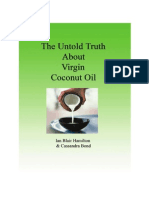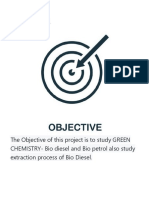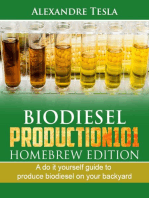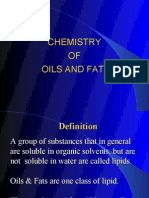To Study The Production of Biodiesel Future Fuel
To Study The Production of Biodiesel Future Fuel
Uploaded by
Aditya MishraCopyright:
Available Formats
To Study The Production of Biodiesel Future Fuel
To Study The Production of Biodiesel Future Fuel
Uploaded by
Aditya MishraOriginal Description:
Original Title
Copyright
Available Formats
Share this document
Did you find this document useful?
Is this content inappropriate?
Copyright:
Available Formats
To Study The Production of Biodiesel Future Fuel
To Study The Production of Biodiesel Future Fuel
Uploaded by
Aditya MishraCopyright:
Available Formats
1
To study the production of
biodiesel future fuel.
Index: -
S. No. Content: - Pg. No.
I Objective 1
II Introduction to green chemistry 2
III BIODIESEL: Using renewable resource 2-3
IV ACTIVITY 1: Making biodiesel 4-6
V ACTIVITY 2: Testing biodiesel 7-9
VI ACTIVITY 3: Potential for biofuels 9-11
The Objective of this project is “To study
the production of biodiesel future fuel”.
2
I. Introduction To Green Chemistry
Green chemistry is the branch of chemistry concerned with
developing processes and production to reduce or
eliminate hazardous substance. One of the goals of green
chemistry is to prevent after it has occurred.
II. Biodiesel: using renewable
resources
Introduction
Bio- diesel is an eco-friendly, alternative diesel fuel
prepared from domestic renewable resources i.e.,
Vegetable oils (edible or non- edible oil) and animal fats.
These naturals oils and fats are made up mainly of
triglycerides. These triglycerides when rea w striking
similarity to petroleum derived diesel and are called “Bio-
diesel”. As India is deficient in edible oils, non-edible oil
may be material of choice for producing bio diesel. For this
purpose, Jatropha curcas considered as most potential
source for it. Bio-diesel is produced by transesterification of
oil obtain from plant.
Jatropha Curcas has been identified for India as the most
suitable tree Borne Oilseed (TBO) for production of bio-
diesel both in view of the non-edible oil available from it
and its presence throughout the country. The capacity of
Jatropha Curcas to rehabilitate degraded or dry lands, from
which the poor mostly derive their sustenance, by
3
improving land’s water retention capacity, makes it
additionally suitable for up gradation of land resources.
Presently, in some Indian village, farmers are extracting oil
from Jatropha and after setting and decanting it they are
mixing the filtered oil with diesel fuel. Although, so far, the
farmers have not observed any damage to their machinery,
yet this remains to be tested and PCRA is working in it, the
fact remains that this oil need to be converted to bio-diesel
Through a chemical reaction – trans-esterification, this
reaction is relatively simple and does not require any exotic
material. IOC (R&D) has been using a laboratory scale plant
of 100% kg/day capacity for trans – esterification; designing
of larger capacity plants is in the offing. These large plants
are useful for centralized production of bio-diesel.
Production of bio-diesel in smaller plant of capacity (e.g.,5
to 20kg/day may also be stared at decentralized level.)
4
ACTIVITY 1: Making Bio-diesel
Biodiesel is a mixture of methyl esters of Fatty acids (long
chain carboxylic acids). It has similar properties to the
diesel fuel made from crude oil that is used to fuel many
vehicles. It can be made easily from vegetable cooking oil
that contains compounds of fatty acids. Enough fuel can be
produced in this activity to burn in a later activity, although
it is not pure enough to actually be used as fuel in a car or
lorry. The synthesis is a simple chemical reaction that
produces biodiesel and propane-1,2,3-triol (glycerol).
Cooking oil is mixed with methanol and potassium
hydroxide is added as a catalyst. The products separate
into two layers, with the biodiesel on the top. The biodiesel
5
is separated and washed, and is then ready for further
experimentation.
What you will need
Eye protection
Access to a top pan balance
One 250cm3 beaker
Two 100cm3 beaker
One 100cm3 measuring cylinder
Five plastic teat pipettes
Distilled water
100cm3 vegetable -based cooking oil
15cm3 methanol (highly flammable, toxic by inhalation,
if swallowed and by skin absorption)
1cm3 potassium hydroxide solution 50% (corrosive).
Safety
6
Wear eye protection
Methanol is flammable and poisonous.
Potassium hydroxide is corrosive.
What to do
1. Measure 100cm3 of vegetable oil into the 250cm3 flask.
Weigh the flask before and after to determine the mass
of oil you used.
2. Carefully add 15cm3 of methanol.
3. Slowly add 1cm3 of 50% potassium hydroxide.
4. Stir or swirl the mixture for 10 minutes.
5. Allow the mixture to stand until it separates into two
layers.
6. Carefully remove the top layer (this is impure biodiesel)
using a teat pipette.
7. Wash the product by shaking it with 10cm3 of distilled
water.
8. Allow the mixture to stand until it separates into two
layers.
9. Carefully remove the top layer of biodiesel using a teat
pipette.
10. Weigh the amount of biodiesel you collected and
compare it to the amount of vegetable you started
with.
7
Apparatus for testing biodiesel
ACTIVITY 2: Testing biodiesel
How does biodiesel compare to other fuels? Just because
we can produce a fuel from an alternative source, does
that mean it is a good idea? There are many factors that
go into the decision to use alternative fuels. Ideally the
physical properties of an alternative fuel should equal or
exceed those of the traditional product. But how are
8
fuels evaluated in the first place. In this activity,
biodiesel and some other fuels are tested and compared
for sootiness and acidity.
What you will need
Eye protection
Small glass funnel (approx. 7cm diameter)
One 250cm3 flask
Two boiling tubes
One two-hole stopper to fir boiling tubes
Filter pump
A piece of wide bore glass tubing approximately
10cm long with two one-hole stopper to fit.
Two short pieces of glass tubing to fit the one-hole
stoppers
5cm glass bend to fit the two-hole stopper
900 glass bend to fit the two-hole stopper (one leg to
extend to bottom of flask)
Two stand and clamp
A little sodium hydroxide 0.1mol dm-3 (irritant)
Universal indicator solution
A little mineral wool.
Safety
1. Wear eye protection.
2. Take care if you have to insert glass tubing into the
stoppers yourself. Make sure that your teacher shows
you the correct technique.
9
What to do
1. Pour 125 cm3 of distilled water into the 250 cm3 flask
and add 10 cm3 of universal indicator. Add one drop of
0.1 mol dm-3 sodium hydroxide solution and gently swirl
the flask so that the colour of the solution is violet or at
the most basic end of the universal indicator colour
range.
2. Place 10 cm3 of this solution into the boiling tube.
3. Assemble the apparatus illustrated in Figure 1,
attaching it to the filter pump with the vacuum tubing.
4. Place 2 cm3 of biodiesel onto a wad of mineral wool in
the metal sample cup.
5. Turn on the water tap so the filter pump pulls air
through the flask and ignite the biodiesel. Position the
funnel directly over the burning fuel, so as to capture
the fumes from the burning fuel. Mark or note the
position of the tap handle so you can run the pump at
the same flow rate later in the experiment.
6. Allow the experiment to run until the universal
indicator turns yellow and time how long this takes.
7. Record what happens in the funnel and in the glass,
tube containing the second piece of mineral wool.
8. Clean the apparatus, and repeat the experiment using 2
cm3 of kerosene (this is very similar to diesel fuel).
Activity 3: Potential for bio fuels
Technical Feasibility
1. Can be blended in any ratio with Petro-diesel
10
2. Existing storage facilities and infrastructure for Petro-
diesel can be used with minor alteration.
3. From environment and emissions point of view it is
superior to Petro-diesel.
4. It can provide energy security to remote and rural
areas.
5. It has good potential for employment generation
Sources of bio-diesel
1. All Tree Bearing Oil (TBO) seeds – edible and non-edible
2. Edible: Soya-bean, Sun-flower, Mustard Oil etc.
3. Non-edible: Jatropha Curcas, Pongemia Pinnata, Neem
etc.
4. Edible seeds can’t be used for bio diesel production in
our country, as its indigenous production does not meet
our current demand.
5. Among non-edible TBO, jatropha Curcas has been
identified as the most suitable seed for India.
Advantage of Jatropha
1. Jatropha Curacs is a widely occurring of TBO
2. It grows practically all over India under a variety of Agro
climatic condition.
3. Can be grown in arid zones (20cm) rainfall as well as in
higher rainfall zones and even on the land with thin soil
cover.
4. Its plantation con be taken up as quick yielding plant
even in adverse land situation viz. degraded and barren
lands under forest and non-forest use, dry and drought
11
prone areas, marginal lands, even on alkaline soils and
as Agro-forestry crops.
5. It grows as a tree up to the height of 3-5 meter.
6. It is a good plantation for Eco-restoration in all type’s
wastelands.
Trans-esterification Process
It is the displacement of alcohol from an ester by
another alcohol in a similar process to hydrolysis.
Vegetable oil i.e., the triglyceride can be easily trans-
esterification in the presence and at temperature of
approximately 60 to 70o with an excess of methanol.
If 100gm of vegetable oil is taken, 1gm of the alkaline
catalyst (potassium hydroxide), and 12gm of methanol
would be required as a first step, the alkaline catalyst is
mixed with methanol and the mixture is stirred for half
an hour for its homogenization. This mixture is mixed
with vegetable oil and the resultant mixture is made to
pass through reflux condensation at 650C.
The mixture at the end is allowed to settle.
The lower layer will be of glycerine and it is drain off.
The upper layer of bio-diesel (a methyl ester) is wished
to remove entrained glycerine.
The excess methanol recycled by distillation.
12
This reaction works well with high quality oil. If the oil
contain1% free fatty acid (FFA), then difficulty arises
because of soap formation. If FFA content is more than
2% the reaction becomes unworkable.
Methanol is flammable and potassium hydroxide is
caustic, hence proper and safe handling of these
chemicals are must.
Thank You.
You might also like
- Chemistry Project On Green Chemistry: Bio-Diesel and Bio-PetrolDocument18 pagesChemistry Project On Green Chemistry: Bio-Diesel and Bio-PetrolFerry Sofat85% (20)
- Tinytech Oil Mill Plant DetailsDocument5 pagesTinytech Oil Mill Plant Detailsrahmad santosoNo ratings yet
- Solid Fat ContentDocument54 pagesSolid Fat ContentNurhayati SurbaktiNo ratings yet
- Untold Truth About COCONUT OilDocument37 pagesUntold Truth About COCONUT Oillihu74100% (4)
- Agmark App FormDocument34 pagesAgmark App FormramcatNo ratings yet
- Ip ProjectDocument19 pagesIp ProjectSoham JadhavNo ratings yet
- Bio DiselDocument13 pagesBio DiselsayanNo ratings yet
- Bio FuelDocument36 pagesBio FuelAmal ManojNo ratings yet
- Bio DiselDocument15 pagesBio DiselAmritansh JaiswalNo ratings yet
- Green ChemistryDocument10 pagesGreen Chemistryvijiramraj786No ratings yet
- Mudit ChemmmmDocument21 pagesMudit ChemmmmPal WalkerNo ratings yet
- Transfer Dock - Text - 20240610190028Document5 pagesTransfer Dock - Text - 20240610190028PrEc丨ᗝuSp尺ΔᑎAvNo ratings yet
- Chemistry Investigatory ProjectDocument27 pagesChemistry Investigatory ProjectTejas NikamNo ratings yet
- Introduction To Green ChemistyDocument21 pagesIntroduction To Green ChemistyHeartykingnkNo ratings yet
- Chemistry ProjectDocument56 pagesChemistry Projectpradeep bijarniaNo ratings yet
- GREEN CHEMISTRY-Bio-Diesel and Bio-Petrol: What You Will NeedDocument6 pagesGREEN CHEMISTRY-Bio-Diesel and Bio-Petrol: What You Will NeedPajiNo ratings yet
- Green Chemistry Bio Diesel PROJECTDocument5 pagesGreen Chemistry Bio Diesel PROJECTSuriyavelu M. S.No ratings yet
- Chem ASLDocument18 pagesChem ASLHuzaifa LokhandwalaNo ratings yet
- Chemistry Project 2Document31 pagesChemistry Project 2Harshit SinghNo ratings yet
- Transfer Dock - Text - 20240608202159Document3 pagesTransfer Dock - Text - 20240608202159PrEc丨ᗝuSp尺ΔᑎAvNo ratings yet
- Bio DieselDocument15 pagesBio DieselAvnish BhasinNo ratings yet
- Chemistry Project On Green Chemistry Bio Diesel and Bio PetrolDocument12 pagesChemistry Project On Green Chemistry Bio Diesel and Bio PetrolPrEc丨ᗝuSp尺ΔᑎAvNo ratings yet
- GREEN CHEMISTRY - Part-2Document12 pagesGREEN CHEMISTRY - Part-2Venkatesh PrasadNo ratings yet
- Biodiesel: Using Renewable Resources: IntroductionDocument3 pagesBiodiesel: Using Renewable Resources: IntroductionElla Camille DinogyaoNo ratings yet
- Chemistry Investigatory Project Class 12 - Green Chemistry - Bio Diesel and Bio PetrolDocument6 pagesChemistry Investigatory Project Class 12 - Green Chemistry - Bio Diesel and Bio PetrolsushantNo ratings yet
- Chemistry Project (Class 12)Document29 pagesChemistry Project (Class 12)Soumyakanta MohapatraNo ratings yet
- ObjectiveDocument24 pagesObjectiveAryan SawlaniNo ratings yet
- Chemistry Investigatory Project On Green Chemistry: by - Khushi Saini XII TH Nalanda Roll No.Document18 pagesChemistry Investigatory Project On Green Chemistry: by - Khushi Saini XII TH Nalanda Roll No.ȺղʂհNo ratings yet
- Chemistryinvestigatoryproject-170126130926 (3) - RemovedDocument30 pagesChemistryinvestigatoryproject-170126130926 (3) - RemovedRaghav SharmaNo ratings yet
- Chem ProjectDocument21 pagesChem Projectjazz fernsNo ratings yet
- Preparation of BiodieselDocument6 pagesPreparation of Biodieselpranjal JaiswalNo ratings yet
- Dokumen - Tips Chemistry Investigatory Project Class 12 Green Chemistry Bio Diesel andDocument34 pagesDokumen - Tips Chemistry Investigatory Project Class 12 Green Chemistry Bio Diesel andlegendgamerz893No ratings yet
- Project Proposal 9thDocument30 pagesProject Proposal 9thJonah Kimetto Kandaa100% (3)
- Green ChemistryDocument32 pagesGreen ChemistryAkshayNo ratings yet
- Production of Biodiesel From Used Vegetable OilDocument4 pagesProduction of Biodiesel From Used Vegetable OilEmmanuelNo ratings yet
- Project by AnushkaDocument19 pagesProject by AnushkaParth RandiveNo ratings yet
- Chemistry Project On Formation of BiodieselDocument3 pagesChemistry Project On Formation of BiodieselYamuna MehtaNo ratings yet
- Small Scale EnterprisesDocument12 pagesSmall Scale EnterprisesanupamishraNo ratings yet
- Chemistry ProjectDocument26 pagesChemistry ProjectMohammad HassanNo ratings yet
- 1.1 BackgroundDocument24 pages1.1 BackgroundFirdaNo ratings yet
- Chemistry 12 1Document33 pagesChemistry 12 1Urmannat KaurNo ratings yet
- Chemistry Investigatory - BiodieselDocument21 pagesChemistry Investigatory - BiodieselRakshith RajaramNo ratings yet
- Presentation 30Document21 pagesPresentation 30ashishkhatik16No ratings yet
- Chemicals Used For ProductionDocument10 pagesChemicals Used For ProductionabdulmatinhublikarNo ratings yet
- Bio DieselDocument9 pagesBio DieselMohan MaheshawariNo ratings yet
- Experiment 9 - Synthesis & Analysis of Biodiesel From Vegetable Oil Via TransesterificationDocument3 pagesExperiment 9 - Synthesis & Analysis of Biodiesel From Vegetable Oil Via TransesterificationLindelwa MthembuNo ratings yet
- JIS ProjectDocument38 pagesJIS Projectrudyfied80No ratings yet
- Chemistry Project Class 12Document17 pagesChemistry Project Class 12Aditya SahooNo ratings yet
- Submitted by P.Ramani: Jatropha OilDocument11 pagesSubmitted by P.Ramani: Jatropha Oilapi-19799369No ratings yet
- Biodiesel Investigatory PaperDocument7 pagesBiodiesel Investigatory PaperJosh Aldrin SarioNo ratings yet
- Project On Green ChemistryDocument39 pagesProject On Green ChemistryHardik Shukla86% (7)
- Custard Apple Seed To FuelDocument6 pagesCustard Apple Seed To FuelAsif Akhtar100% (1)
- PRIYANKADocument14 pagesPRIYANKAaryanswain0007No ratings yet
- Dept. of Mechanical Engineering K K I T Engg College: A Sucessful Alternative FuelDocument16 pagesDept. of Mechanical Engineering K K I T Engg College: A Sucessful Alternative FuelSrini Vasulu100% (1)
- Chemistry 457Document19 pagesChemistry 457Ishan VermaNo ratings yet
- Project Work of Chemistry On BiodieselsDocument23 pagesProject Work of Chemistry On BiodieselssushantNo ratings yet
- Rsults T B CHCKDocument8 pagesRsults T B CHCKabdulmatinhublikarNo ratings yet
- Chemistry Class 12 ProjectDocument14 pagesChemistry Class 12 ProjectGhost AnkanNo ratings yet
- The Next Generation Sustainable Fuel: Jatropha CurcasDocument5 pagesThe Next Generation Sustainable Fuel: Jatropha CurcasAJER JOURNALNo ratings yet
- The BiodeiselDocument107 pagesThe Biodeiselabdisahurisa24No ratings yet
- ALGAEOLEUMDocument7 pagesALGAEOLEUMS Bharadwaj ReddyNo ratings yet
- Inrmation An FiursDocument9 pagesInrmation An FiursabdulmatinhublikarNo ratings yet
- Lab Workshop BIODIESELmicroscale 07Document7 pagesLab Workshop BIODIESELmicroscale 07atz KusainNo ratings yet
- Biodiesel Production101: Homebrew Edition: A Do It Yourself Guide to Produce Biodiesel on Your BackyardFrom EverandBiodiesel Production101: Homebrew Edition: A Do It Yourself Guide to Produce Biodiesel on Your BackyardNo ratings yet
- Quantitative Analysis of Coconut WaterDocument13 pagesQuantitative Analysis of Coconut WaterAditya Mishra100% (1)
- MCQs Planning in Sports-1Document3 pagesMCQs Planning in Sports-1Aditya MishraNo ratings yet
- Diffusion of Solids in LiquidsDocument8 pagesDiffusion of Solids in LiquidsAditya MishraNo ratings yet
- Army Public School Nasirabad 2021-2022Document3 pagesArmy Public School Nasirabad 2021-2022Aditya MishraNo ratings yet
- Cooking OilDocument6 pagesCooking OilMAGOMU DAN DAVIDNo ratings yet
- Density, Viscosity, and Surface Tension of Five Vegetable Oils at Elevated Temperatures: Measurement and ModelingDocument18 pagesDensity, Viscosity, and Surface Tension of Five Vegetable Oils at Elevated Temperatures: Measurement and ModelingMUHAMMAD LUFFINo ratings yet
- Palm Supply, Demand & Industry OutlookDocument4 pagesPalm Supply, Demand & Industry OutlookJunguang TanNo ratings yet
- Unit Processing MethodsDocument12 pagesUnit Processing MethodsIsabella DonatoNo ratings yet
- Effect of Blending On Physico-Chemical Properties of Palm Oil and Palm Oil Products With Soyabean OilDocument8 pagesEffect of Blending On Physico-Chemical Properties of Palm Oil and Palm Oil Products With Soyabean OilAristonNo ratings yet
- Fuels and Lubricants PDFDocument99 pagesFuels and Lubricants PDFShamveel Taiyab0% (1)
- Biodiesel - A Fuel of FutureDocument5 pagesBiodiesel - A Fuel of FutureYashad JoshiNo ratings yet
- GSO-1754!2!2013-E Edible Vegetable Oils - Part 2Document14 pagesGSO-1754!2!2013-E Edible Vegetable Oils - Part 2Karthik BhandaryNo ratings yet
- Singapore Customs India List of Items Excluded From Pref RateDocument142 pagesSingapore Customs India List of Items Excluded From Pref RatesureshNo ratings yet
- Dairy Products: Dairy, Fats and OilDocument9 pagesDairy Products: Dairy, Fats and OilMichael FabonNo ratings yet
- Food Licensce Business Vintage ProofDocument7 pagesFood Licensce Business Vintage ProofSubramanyam JonnaNo ratings yet
- Vantage Product Brochure 2017-r3Document25 pagesVantage Product Brochure 2017-r3Andrea Serrano TorresNo ratings yet
- Chapter 3: Hydrolysis of Vegetable Oils and Animal FatDocument27 pagesChapter 3: Hydrolysis of Vegetable Oils and Animal FatSamiNo ratings yet
- CastorDocument112 pagesCastoryoantan haileNo ratings yet
- Actifry Recipe BookDocument60 pagesActifry Recipe BookDerrick Yang50% (2)
- Instant Noodle ProductionDocument13 pagesInstant Noodle ProductionHazreen MokhtiarNo ratings yet
- Project On Vadilal & Mother Dairy by NeerajDocument60 pagesProject On Vadilal & Mother Dairy by NeerajNeeraj Singh Bisht33% (6)
- Production of Vegetable Oil Fatty Acid Methyl Este PDFDocument10 pagesProduction of Vegetable Oil Fatty Acid Methyl Este PDFSagar DhuriNo ratings yet
- Cargill: A Threat To Food and FarmingDocument20 pagesCargill: A Threat To Food and FarmingFood and Water Watch91% (11)
- Lec 1-Nutrition and TechnologyDocument9 pagesLec 1-Nutrition and TechnologyNaqaa AlomariNo ratings yet
- Development of Engine Oil Using Palm Oil As A Base Stock For Four-Stroke EnginesDocument5 pagesDevelopment of Engine Oil Using Palm Oil As A Base Stock For Four-Stroke EnginesShahabuddin SuzanNo ratings yet
- Biodiesel Fuels From Vegetable Oils: Transesterification of Cynara Cardunculus L. Oils With EthanolDocument8 pagesBiodiesel Fuels From Vegetable Oils: Transesterification of Cynara Cardunculus L. Oils With EthanolVaibhav MoonNo ratings yet
- CXS 251-2022Document5 pagesCXS 251-2022Md. Ashaf Hossain SarkerNo ratings yet
- Cpopc Outlook 2022Document11 pagesCpopc Outlook 2022Tar MiziNo ratings yet
- Vegetable Oil Usage in LubricantsDocument4 pagesVegetable Oil Usage in LubricantsKevin TravisNo ratings yet
- Chemistry of Fats & OilsDocument38 pagesChemistry of Fats & OilsSubhajit SarkarNo ratings yet





























































































